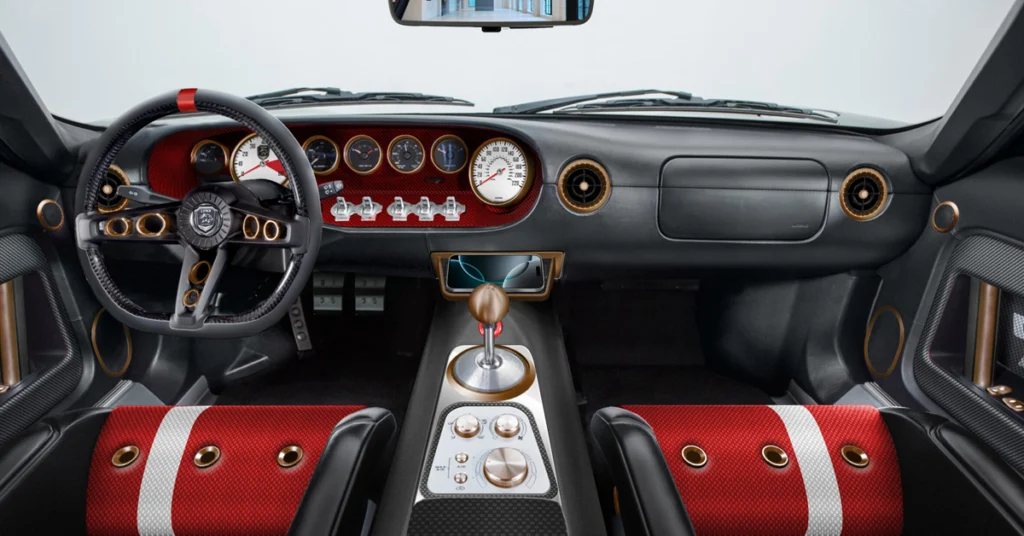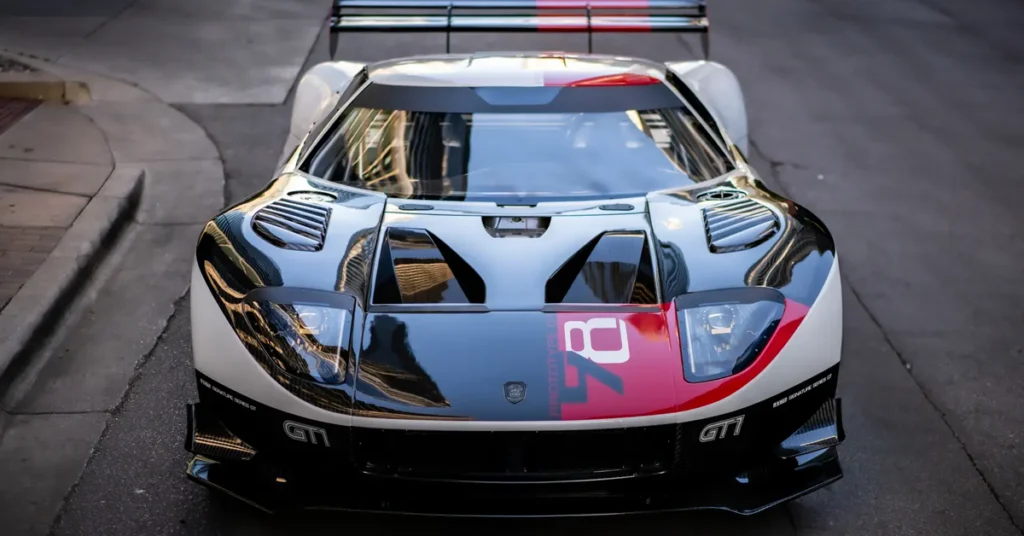Image credit: https://lynx.car/press-and-media
When people talk about Ford’s greatest racing icons, two cars usually dominate the conversation. The first is the GT40, the car that humbled Ferrari at Le Mans in the 1960s and went on to claim four consecutive wins. The second is the modern Ford GT, which stormed endurance racing once again in 2016, this time conquering its class at Le Mans.
But what often gets overlooked is the modern Ford GT that debuted in 2005. Built as a tribute to the GT40, it was never meant to compete on the track. Still, it didn’t take long before a group of ambitious engineers decided to change that. In 2010, Swiss outfit Matech Competition transformed the road-going Ford GT into a full-blown FIA GT1 racer. The GT1 series was short-lived, and Ford’s entry never achieved the kind of glory its ancestors enjoyed. Yet the car left behind something unique: a purebred racing platform that most people never got to see outside the paddock. Fast forward to today, and Lynx Motors has decided that chapter deserves a second chance. In partnership with Graham Rahal Performance in Indiana, the company is building the Lynx GT1, a road-legal car that takes the spirit of Matech’s racer and adapts it for everyday roads. This is not just another supercar project. It’s an effort to bring a forgotten racing legend back into the spotlight, but this time, for the streets
The Forgotten Racing Chapter of the Ford GT
The 2005–2006 Ford GT was built as a modern homage to the original GT40. Its design language was unmistakably retro, but under the skin it carried modern engineering, including a supercharged 5.4-liter V8 that pushed it well past 300 km/h. Unlike its forebear or its eventual successor, this GT wasn’t born with racing in mind. It was a halo car, built to celebrate Ford’s centennial and show the world what the Blue Oval could do when it aimed high.
Matech Competition, however, saw an opportunity. Using GT chassis that had never been destined for racing, they created a machine that could compete in the FIA GT1 World Championship. That series pitted cars like the Audi R8, Lamborghini Murciélago, and Nissan GT-R against each other in door-to-door battles at iconic circuits. The Ford GT1 may not have racked up wins like its rivals, but it became one of the most visually striking machines on the grid.
The championship itself folded after only three seasons, but the cars didn’t disappear. Instead, they became prized artifacts of an experimental era when supercars were adapted into brutes for global endurance and sprint races.
From Race Car to Road Car
This is where Lynx Motors steps in. Based in Texas, the company saw potential in resurrecting the GT1 for modern enthusiasts. Partnering with Graham Rahal Performance in Zionsville, Indiana the workshop run by IndyCar driver Graham Rahal they set out to build 28 road-legal Lynx GT1s.
What makes this project so special is that it isn’t starting from scratch. Lynx has sourced original chassis Matech had purchased for its racing program. These aren’t replicas or reinterpretations they’re genuine racing skeletons, reborn as road cars. That DNA separates the GT1 from typical continuation builds or modified supercars. It’s more than a tribute. It’s a transformation.
Power and Performance Beyond the Numbers
Under the hood, the Lynx GT1 doesn’t settle for “fast enough.” The base setup starts with the same 5.4-liter supercharged V8 from the Ford GT, which originally delivered about 410 kilowatts in stock form. With tuning, Lynx aims to push that figure well past 895 kilowatts. That’s more than double the output of the original car and enough to rival today’s hypercars.
For those who want something even more extreme, Lynx offers a rare alternative: Matech’s twin-turbocharged 7.0-liter V8 engines. These monsters are capable of producing between 1,400 and 1,500 horsepower, paired with a Sadev sequential gearbox. It’s the closest you can get to driving a genuine GT1 race car on public roads.
Transmission choices reflect the dual nature of the project. Purists will love the Ricardo 6-speed manual, a direct link to the Ford GT’s heritage. Those craving a rawer, track-focused experience can opt for the race-bred sequential box, complete with lightning-fast shifts.
When you consider the power-to-weight ratio of a carbon-bodied GT1 chassis, it’s clear this car belongs in the same conversation as modern hypercars like the Bugatti Chiron or Aston Martin Valkyrie but with a purer, more analog feel.
Aerodynamics Born on the Circuit
The Lynx GT1 doesn’t just borrow its engine from racing. Its bodywork and aerodynamics are straight from Matech’s competition playbook. The widened carbon-fiber panels, dive planes, and massive rear diffuser are designed to slice air and pin the car to the ground at speed.
Compared to the smoother, more restrained lines of the 2005 Ford GT, the GT1 looks like it was designed with no compromises. And in truth, it was. The only tweaks for road use involve making sure it can survive potholes, speed bumps, and the occasional grocery run if you’re brave enough.
This raises an interesting question: can a car this extreme work outside the track? Lynx believes it can, provided owners are willing to treat it with respect. Think of it less as a daily commuter and more as a statement piece you can unleash on open highways or at private track days.
Inside the Lynx GT1

Step inside the cockpit, and the theme continues: race car first, road car second. The analog gauges and center-mounted shifter give it a purposeful, motorsport vibe. Yet Lynx has made sure the essentials of modern life aren’t forgotten. Apple CarPlay, a phone charging pad, and custom interior options add just enough comfort to make it livable.
Seats come from names every racer knows Recaro, Sparco, Manthey Racing with choices between three-point or five-point harnesses. Buyers can pick their trim materials, interior colors, and even design their own gauge clusters. No two GT1s will look alike. That uniqueness is part of the appeal: every car is literally one of one.
The Craft of Building a One-Off Supercar
Building a car like this isn’t a mass-production affair. Each Lynx GT1 takes around eight months to assemble at Graham Rahal Performance. Every panel, every component, and every system is carefully adapted to meet the demands of both the road and the legacy of Matech’s original design.
This handcrafted approach is what separates boutique projects from corporate hypercars. While mainstream brands chase production numbers and balance sheets, builders like Lynx are focused on detail, authenticity, and storytelling. Each customer becomes part of that story, with a car tailored specifically to them.
A Place in Today’s Supercar Landscape
The Lynx GT1 enters a world already saturated with incredible machines, from hybrid hypercars to all-electric speed demons. But its appeal lies in being different. It isn’t chasing the latest tech or the quietest cabin. It’s about giving drivers the visceral thrill of piloting a race car, wrapped in a package that’s legal for the street.
Other manufacturers have tried similar projects, like Mercedes with its road-legal CLK GTR or McLaren with the P1 GTR conversions. But the Lynx GT1 stands apart because it starts with an authentic racing base that very few people ever had access to. That heritage gives it instant credibility and collectability.
Collectability and Enthusiast Value
With only 28 examples planned, each car’s rarity is guaranteed. Add in its racing lineage, bespoke craftsmanship, and VIN certification for road use, and you have a car destined for collector status. For enthusiasts, it’s not just about owning a fast car. It’s about owning a piece of history that bridges the gap between track and street in a way few others can
Conclusion
The Lynx GT1 is proof that forgotten chapters of motorsport history don’t have to stay forgotten. By reviving Matech’s Ford GT1 racer as a road car, Lynx Motors has created something both nostalgic and cutting-edge. It’s a car that speaks to collectors, drivers, and dreamers alike a blend of pure racing aggression and road-worthy adaptability. In a world of polished hypercars, the GT1 feels refreshingly raw, honest, and alive.
Where Supercar Dreams Meet the Streets of UAE
From the wide highways of Dubai to the mountain passes of Ras Al Khaimah, the UAE has always been a playground for performance cars. At MotorHub, we bring global automotive stories like the Lynx GT1 to local enthusiasts while also connecting drivers with trusted workshops across the Emirates. Whether you own a classic, a daily driver, or a hypercar, MotorHub helps you find expert service and care right here in the UAE.



